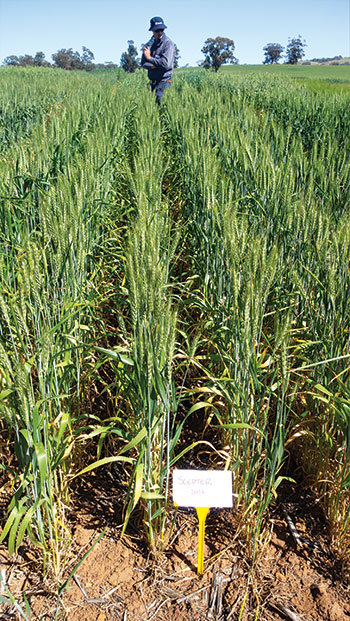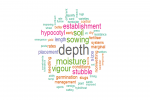More than a curiosity, wheat varieties of the past are providing a unique insight into genetic solutions for the future
At the University of Melbourne’s Dookie campus in Victoria’s north-east, a seemingly ordinary paddock is playing host to an extraordinary set of wheat varieties.
Planted side-by-side by self-confessed “wheat-nerd” James Hunt, a University of Melbourne professor and holder of the William Farrer Lectureship in Agronomy, the varieties represent the major cultivars grown in the region dating back more than 120 years.
Professor Hunt says the plots are a celebration of the pivotal role that the Dookie campus played in national wheat breeding at the turn of the 20th century.
Hugh Pye, who was the principal at Dookie College from 1894 to 1916, was also a pioneering wheat breeder and a correspondent of (Federation wheat breeder) William Farrer,” he says. “And by the 1920s, Pye’s cultivar Currawa, bred at Dookie, was second only to Federation as the most widely grown wheat variety in the country.
Today, Professor Hunt has brought those cultivars back to life.
There is Federation – the famous variety credited with transforming the Australian wheat industry after it was released in 1901 – standing green, tall and erect alongside the leafier College Purple produced in the same year. There is the spindly Purple Straw (1860), from which Pye created College Purple, and there is his most successful cultivar, Currawa, named after the hill on which the college was built. Currawa was distributed in 1912.
 Scepter(PBR)(2016), bred by Australian Grain Technologies at Roseworthy, SA. Scepter(PBR)is arguably Australia’s most widely grown wheat variety. Photo: Melissa Marino
Scepter(PBR)(2016), bred by Australian Grain Technologies at Roseworthy, SA. Scepter(PBR)is arguably Australia’s most widely grown wheat variety. Photo: Melissa Marino
Looking back to look forward
There are modern varieties Sunmaster and Scepter, planted for comparison, along with the first commercial semi-dwarf varieties Millewa (1978) and the soft biscuit wheat Egret from 1973 that, according to Dookie locals, “yielded the pants off everything else when it came out”.
And there is also Professor Hunt’s sentimental favourite, Insignia, from 1946 – the variety his grandfather first grew on the family’s Normanville farm when he returned from World War II. It was notably shorter than everything that had preceded it.
“His big technological innovation was to buy some Insignia seed, and his father mocked him because it didn’t grow over the fence. Back then the thinking was it had to be tall to yield well,” he says. “And then they put the header in it and (it) absolutely smoked everything else. It would still give some of the modern varieties a bit of a fright.”
The historical plots of milling wheats provide a fascinating window into the past for the university’s agriculture students. But they are more than simply a curiosity; they also offer an insight that may help breeders address issues of the future. Over time, wheat breeding in Australia – much supported by GRDC investment – has increased yields by 25 kilograms per hectare per year.
Having the historical cultivars planted in the one place allows researchers to assess how breeding has impacted genetic yield gain over time, Professor Hunt says.
For example, characteristics such as height, light penetration through the canopy, and the amount of dry matter partitioned to the spike have contributed to these gains, he says.
This is illustrated at Dookie where the shorter flag leaves of the modern varieties allow for more light penetration than the long floppy leaves of a variety such as Olympic from 1956.
“You can see you have much more light reaching the bottom of the canopy in a variety such as Sunmaster, and in Scepter you’ve got a much bigger spike relative to stem – so the plant is partitioning more of its biomass into the reproductive parts that give you the grain,” he says.
“So I think understanding how breeding has changed cultivars prompts us to think about how we need to change cultivars in the future.”
Traits of the older varieties could help to address modern challenges facing farming systems such as weed control, Professor Hunt says. “Those early cultivars, for example, were very competitive with weeds, and so if we get into a more restricted environment in terms of what chemicals we can use, we could look back to those more competitive phenotypes for traits to incorporate.”
The plots, planted with seeds sourced from the Australian Grains Gene Bank in Horsham, are part of a renewed focus on grain research at Dookie led by Professor Hunt.
They are among other field experiments at the campus that are supported by GRDC. This research compares a range of winter and spring wheats, as well as European and Australian cultivars, to build a big picture of genetic diversity and performance to inform agronomy and fast-track future breeding efforts.
“Dookie once was the place for wheat research and breeding, and hopefully we can make it so again,” Professor Hunt says.
More information: One of the world’s largest variety comparisons occurs each year via the NVT program. See GroundCover™ Supplement: Celebrating 20 years of NVT

























































